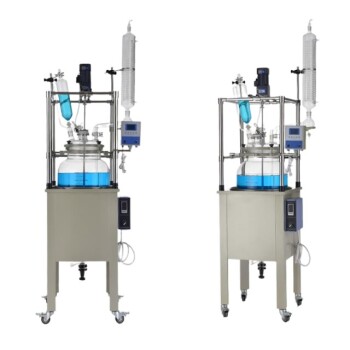A jacketed vessel is a specialized container designed for precise temperature control of its contents, which may include hazardous or sensitive materials. It achieves this by using a jacket—a secondary layer surrounding the vessel—that circulates a heating or cooling medium, such as water or oil. This medium is pumped through the jacket to regulate the temperature of the vessel's contents, ensuring uniformity and stability. The jacket also provides insulation to prevent heat loss or gain. Jacketed vessels are commonly used in chemical reactions, pharmaceutical production, and other processes requiring controlled thermal conditions. They can operate in batch or continuous modes and often include additional features like stirring, dosing, and sampling mechanisms to enhance efficiency and safety.
Key Points Explained:

-
Purpose of a Jacketed Vessel:
- Jacketed vessels are designed for custom temperature control of their contents, particularly for hazardous or sensitive materials.
- They maintain uniform internal conditions, ensuring consistent reaction temperatures and preventing unwanted thermal fluctuations.
-
How the Jacket Works:
- The jacket is a secondary layer surrounding the vessel, filled with a heating or cooling medium (e.g., water, oil, or steam).
- A pump circulates the medium through the jacket, enabling precise temperature regulation of the vessel's contents.
- The jacket also acts as insulation, minimizing heat loss or gain and maintaining stable internal conditions.
-
Types of Jackets:
- Single Jacket Systems: Circulate a single medium (heating or cooling) around the vessel.
- Double Jacket Systems: Use an inner jacket for liquid circulation and an outer jacket for vacuum insulation, providing enhanced temperature control and efficiency.
-
Components of a Jacketed Reactor:
- Stirring Mechanism: Ensures uniform mixing of reactants, improving reaction efficiency.
- Dosing Mechanism: Allows controlled addition of reactants or additives during the process.
- Sampling Mechanism: Enables periodic extraction of samples for analysis without disrupting the reaction.
-
Applications:
- Jacketed vessels are widely used in chemical, pharmaceutical, and food industries for processes requiring precise temperature control.
- They are ideal for scaling up reactions, increasing yield, and improving product quality.
-
Advantages:
- Temperature Control: Enables precise regulation of reaction conditions, leading to consistent and reliable results.
- Versatility: Can handle both batch and continuous processes, making them suitable for a wide range of applications.
- Safety: Provides a controlled environment for handling hazardous or sensitive materials.
-
Operation Modes:
- Batch Process: Reactants are added at the start, and the reaction proceeds until completion. Products are removed at the end.
- Continuous Process: Reactants are continuously fed into the vessel, and products are continuously withdrawn, allowing for uninterrupted operation.
-
Heat Exchange Mechanism:
- The jacket facilitates uniform heat exchange between the circulating medium and the vessel walls, ensuring even temperature distribution throughout the vessel.
By combining these features, jacketed vessels offer a reliable and efficient solution for processes requiring precise temperature control, making them indispensable in industries where thermal regulation is critical.
Summary Table:
| Feature | Description |
|---|---|
| Purpose | Custom temperature control for hazardous or sensitive materials. |
| Jacket Function | Circulates heating/cooling medium (e.g., water, oil) for precise regulation. |
| Types of Jackets | Single Jacket (one medium) or Double Jacket (enhanced control with insulation). |
| Key Components | Stirring, dosing, and sampling mechanisms for efficiency and safety. |
| Applications | Chemical, pharmaceutical, and food industries. |
| Advantages | Precise temperature control, versatility, and safety. |
| Operation Modes | Batch or continuous processes. |
Need a jacketed vessel for your process? Contact us today to find the perfect solution!


















